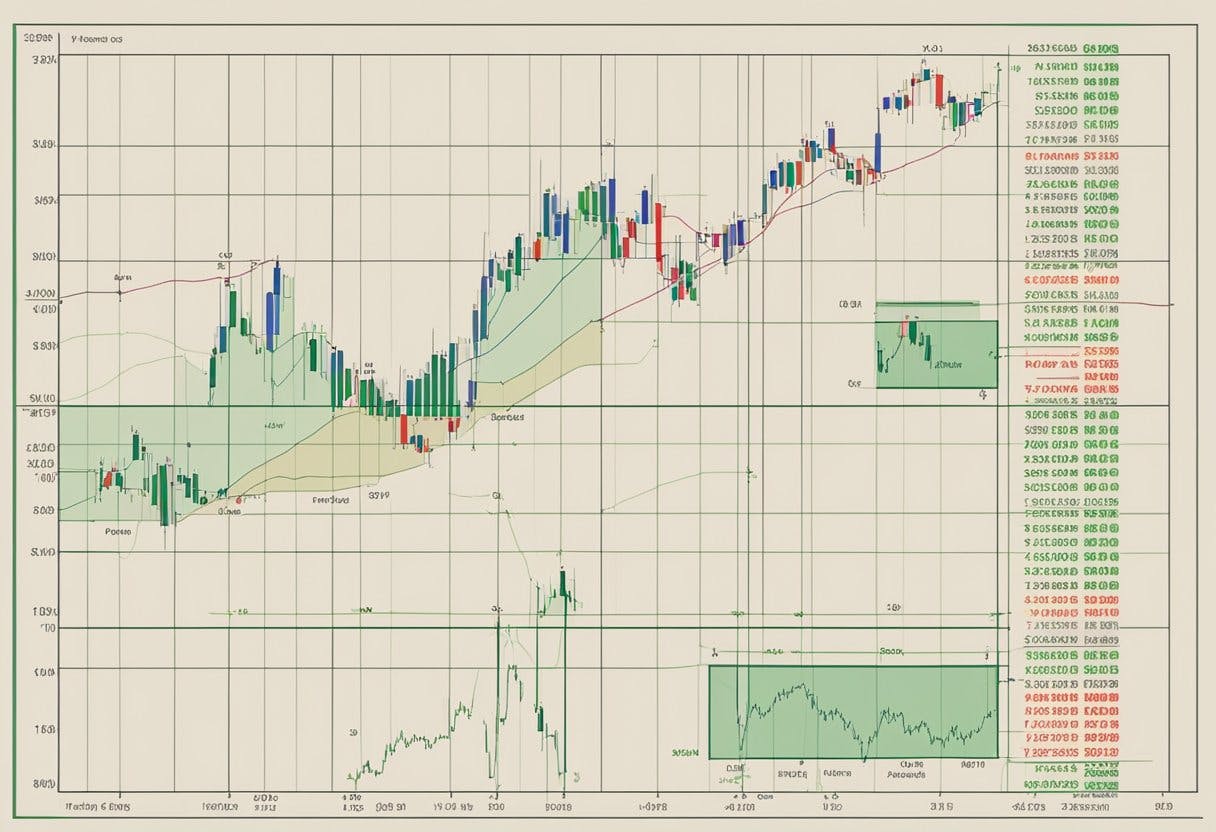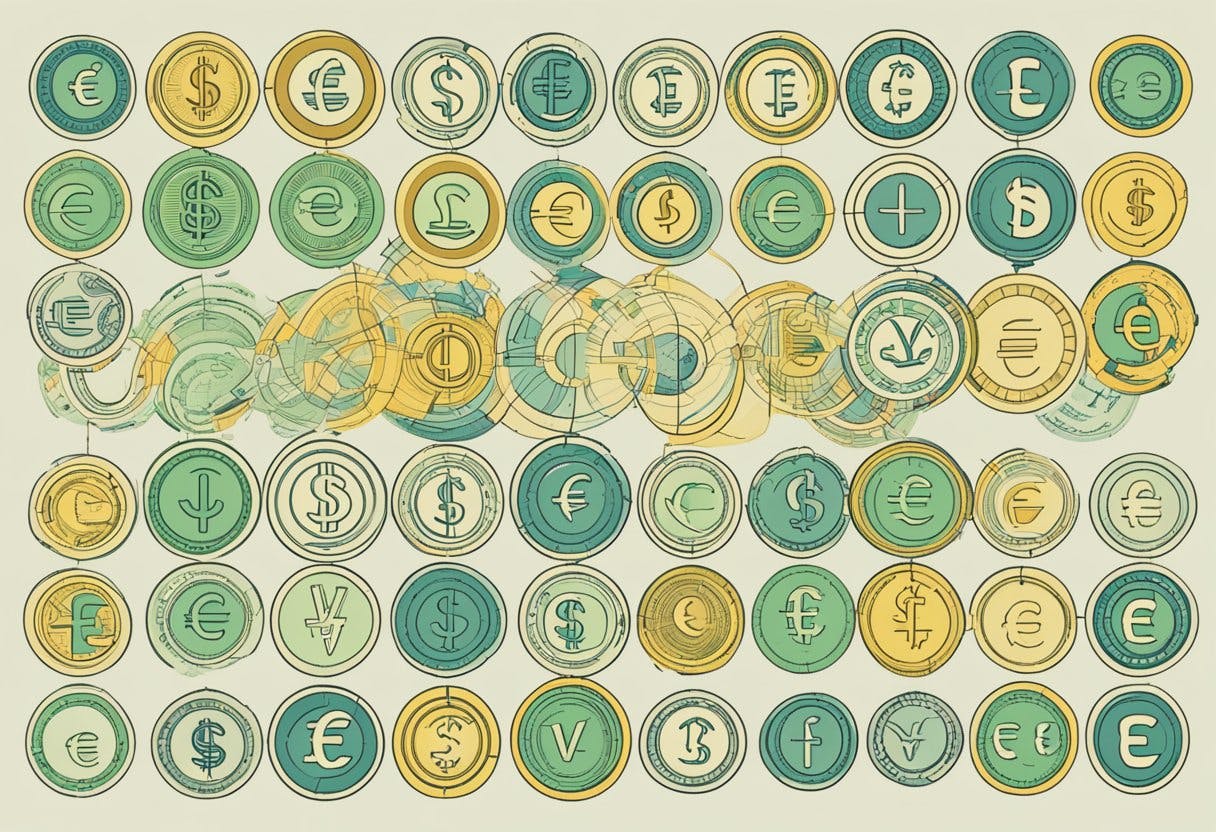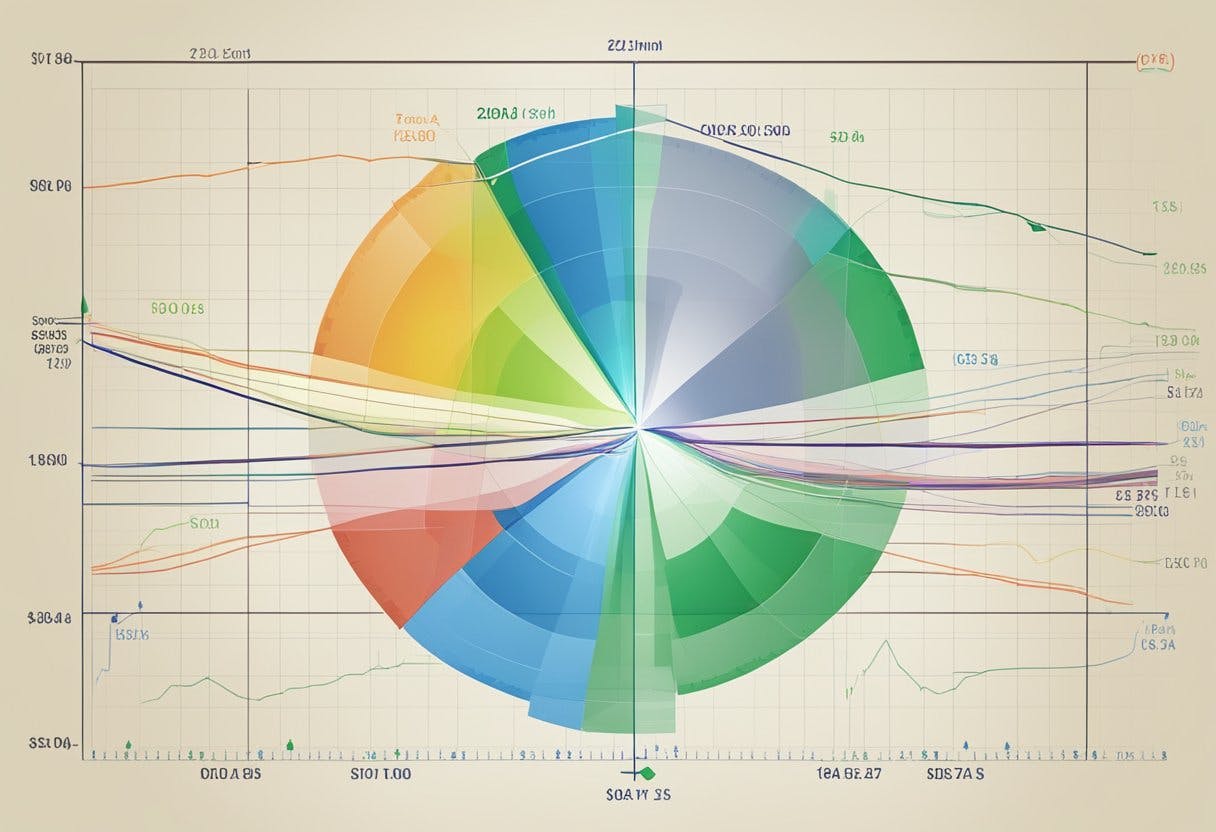
Currency correlations are an essential aspect of forex trading. Understanding how currency pairs move in relation to one another can help traders make informed decisions about when to enter or exit trades. In this article, we will explore what currency correlations are, how they work, and how traders can use them to their advantage.

Currency correlations refer to the relationship between two or more currency pairs and how they move in relation to each other. A positive correlation between two currency pairs means that they tend to move in the same direction, while a negative correlation means they tend to move in opposite directions. Understanding currency correlations is crucial for forex traders because it can help them diversify their portfolios, hedge their positions, and manage risk.
There are different types of currency correlations that traders should be aware of, such as short-term and long-term correlations, and strong and weak correlations. Traders can also use various tools and resources to track currency correlations and analyze them in different market conditions. By understanding these correlations, traders can develop effective forex trading strategies that can help them achieve their goals.
Key Takeaways
- Understanding currency correlations is crucial for forex traders to make informed decisions.
- There are different types of currency correlations, including short-term and long-term correlations, and strong and weak correlations.
- Traders can use various tools and resources to track currency correlations and analyze them in different market conditions.
Understanding Currency Pairs and Correlation

The Basics of Currency Pairs
In Forex trading, currency pairs are the most fundamental aspect. A currency pair is a combination of two currencies, where the first currency is called the base currency, and the second currency is called the quote currency. For example, in the EUR/USD currency pair, the EUR is the base currency, and the USD is the quote currency.
Traders buy or sell a currency pair based on their belief that the base currency will appreciate or depreciate against the quote currency. For instance, if a trader buys the EUR/USD currency pair, they are buying the EUR and selling the USD, expecting the EUR to appreciate against the USD.
Defining Correlation in Forex
In Forex trading, correlation measures how currency pairs move in relation to each other. Correlation is expressed as a value between -1 and +1. A correlation of +1 indicates a perfect positive correlation, meaning that the two currency pairs move in the same direction. Conversely, a correlation of -1 indicates a perfect negative correlation, meaning that the two currency pairs move in opposite directions. A correlation of 0 indicates no relationship between the two currency pairs.
Calculating Correlation Coefficients
Traders use correlation coefficients to measure the degree of correlation between two currency pairs. The correlation coefficient is a statistical measure that ranges from -1 to +1. The closer the correlation coefficient is to +1, the stronger the positive correlation between the two currency pairs. Conversely, the closer the correlation coefficient is to -1, the stronger the negative correlation between the two currency pairs. A correlation coefficient of 0 indicates no correlation between the two currency pairs.
To calculate the correlation coefficient between two currency pairs, traders use a formula that involves the standard deviation and covariance of the two currency pairs. However, traders can also use various Forex tools and platforms that automatically calculate the correlation coefficients between currency pairs.
Overall, understanding currency pairs and correlation is essential for Forex traders to make informed trading decisions. By analyzing the correlation between currency pairs, traders can identify potential trading opportunities and manage their risk effectively.
Types of Currency Correlations

Currency correlation refers to the relationship between two or more currency pairs. There are three types of currency correlations: positive correlation, negative correlation, and no correlation.
Positive Correlation
Positive correlation occurs when two currency pairs move in the same direction. For example, if the EUR/USD and GBP/USD both go up or down together, they have a positive correlation. Positive correlation can be seen when the economies of the countries that issue the currencies are interdependent.
When two currencies are positively correlated, traders can use this information to their advantage by trading in the same direction. For example, if the EUR/USD is in an uptrend, a trader can look for opportunities to buy the GBP/USD, which is also in an uptrend.
Negative Correlation
Negative correlation occurs when two currency pairs move in opposite directions. For example, if the USD/JPY goes up while the EUR/USD goes down, they have a negative correlation. Negative correlation can be seen when the economies of the countries that issue the currencies are not interdependent.
When two currencies are negatively correlated, traders need to be careful when trading them. If a trader buys one currency pair and sells the other, they are essentially taking opposite positions. This can be risky because if one trade goes wrong, the other trade will also suffer.
Traders can use currency correlation to manage their risk by diversifying their trades. For example, if a trader wants to buy the EUR/USD, they can also buy the USD/CHF, which has a negative correlation with the EUR/USD. This way, if the EUR/USD trade goes wrong, the USD/CHF trade can make up for the loss.
In conclusion, understanding currency correlation is an important aspect of forex trading. Positive correlation occurs when two currency pairs move in the same direction, while negative correlation occurs when two currency pairs move in opposite directions. Traders can use currency correlation to manage their risk and diversify their trades.
Applying Correlations to Forex Trading Strategies

Currency correlations can be a valuable tool for traders to develop effective Forex trading strategies. By understanding the relationships between different currency pairs, traders can make informed decisions about which trades to make and when to make them.
Strategies for Correlated Pairs
When two currency pairs are positively correlated, they tend to move in the same direction. Similarly, when two currency pairs are negatively correlated, they tend to move in opposite directions. Traders can use this information to their advantage by looking for opportunities to trade multiple currency pairs that are correlated with each other. For example, if a trader believes that the Euro will strengthen against the US dollar, they may also consider trading the Swiss Franc against the US dollar, as the Euro and Swiss Franc are positively correlated.
Hedging with Currency Correlations
Currency correlations can also be used for hedging purposes. Hedging involves taking a position in one currency pair to offset the risk in another currency pair. For example, if a trader has a long position in the Euro against the US dollar, they may also take a short position in the Swiss Franc against the US dollar to hedge their risk. By doing so, they can offset any potential losses in their Euro position with gains in their Swiss Franc position.
Risk Management and Diversification
Using currency correlations can also help traders manage risk and diversify their portfolios. By trading multiple currency pairs that are not highly correlated with each other, traders can reduce their overall portfolio risk. For example, if a trader has a long position in the Euro against the US dollar, they may also consider taking a short position in the Australian dollar against the US dollar, as the two currency pairs are not highly correlated with each other. By doing so, they can reduce their overall portfolio risk and increase their chances of success.
Overall, understanding currency correlations and applying them to Forex trading strategies can be a valuable tool for traders. By using correlations to identify trading opportunities, hedge risk, and diversify portfolios, traders can increase their chances of success in the Forex market.
Analyzing Correlations in Different Market Conditions
When trading Forex, it is important to understand how different market conditions can impact currency correlations. This section will explore some of the key factors that can impact currency correlations and how traders can analyze these correlations to make informed trading decisions.
Impact of Economic Events
Economic events can have a significant impact on currency correlations. For example, when a central bank raises interest rates, it can cause the currency to appreciate, which can in turn impact the correlation between that currency and other currencies. Traders can use economic data releases to identify potential changes in currency correlations and adjust their trading strategies accordingly.
Commodities and Currency Correlations
Commodity prices, particularly oil and gold, can also impact currency correlations. For example, when oil prices rise, it can lead to an increase in the value of commodity currencies such as the Canadian dollar and the Australian dollar. Traders can use commodity prices to identify potential changes in currency correlations and adjust their trading strategies accordingly.
Correlations and Market Volatility
Market volatility can also impact currency correlations. When markets are volatile, correlations between currencies can break down, leading to unexpected moves in currency pairs. Traders can use volatility measures such as the VIX index to identify potential changes in currency correlations and adjust their trading strategies accordingly.
In summary, analyzing currency correlations in different market conditions is an important part of Forex trading. Traders should keep an eye on economic events, commodity prices, and market volatility to identify potential changes in currency correlations and adjust their trading strategies accordingly. By doing so, traders can make more informed trading decisions and improve their chances of success in the Forex market.
Tools and Resources for Tracking Forex Correlations
When it comes to tracking currency correlations in forex trading, there are several tools and resources available. These tools can help traders gain a better understanding of how different currency pairs move in relation to one another, and can be used to identify potential trading opportunities.
Currency Correlation Tables and Charts
Currency correlation tables and charts are a common tool used by forex traders to track correlations between different currency pairs. These tables and charts provide an overview of the correlation between pairs over a specific period, and can be used to identify pairs that are highly correlated or inversely correlated.
Some forex trading platforms, such as MetaTrader 4, provide built-in currency correlation tables and charts. Additionally, there are several websites and software programs that offer free or paid currency correlation tables and charts, such as FOREX.com and MyFXbook.
Software and Calculators
In addition to currency correlation tables and charts, there are several software programs and calculators available that can help traders track forex correlations. One popular software program is Microsoft Excel, which can be used to create custom currency correlation tables and charts.
There are also several free and paid forex correlation calculators available, such as the one offered by ZuluTrade. These calculators allow traders to input currency pairs and timeframes to generate correlation coefficients and matrices.
Real-Time Correlation Indicators
Real-time correlation indicators are another tool that traders can use to track forex correlations. These indicators are typically included in forex trading platforms, and provide real-time updates on currency correlations as they change.
Forex trading platforms such as MetaTrader 4 and 5 offer built-in real-time correlation indicators. Additionally, there are several third-party indicators available, such as the Forex Correlation Matrix offered by FXSSI.
Overall, there are several tools and resources available to help traders track forex correlations. Whether traders prefer to use currency correlation tables and charts, software and calculators, or real-time correlation indicators, these tools can help traders gain a better understanding of how different currency pairs move in relation to one another.
Frequently Asked Questions
How do currency correlations affect forex trading strategies?
Currency correlations can have a significant impact on forex trading strategies. Understanding the correlation between currency pairs can help traders identify potential opportunities and risks. For example, if two currency pairs are positively correlated, a trader might use this information to hedge their positions or to diversify their portfolio. On the other hand, if two currency pairs are negatively correlated, a trader might use this information to avoid taking positions that might cancel each other out.
What are the most common positively correlated forex pairs?
The most common positively correlated forex pairs are those that involve currencies from countries with similar economies. For example, the EUR/USD and the GBP/USD are typically positively correlated because the economies of Europe and the UK are closely linked. Similarly, the USD/CAD and the AUD/USD are often positively correlated because they involve currencies from countries that are rich in natural resources.
Which forex pairs typically exhibit negative correlation?
Forex pairs that typically exhibit negative correlation include those that involve currencies from countries with very different economies. For example, the USD/JPY and the EUR/USD are often negatively correlated because the economies of the US and Japan are very different. Similarly, the USD/CHF and the GBP/USD are often negatively correlated because the Swiss economy is very different from that of the UK.
What tools can be used to calculate currency correlations in forex trading?
There are several tools that can be used to calculate currency correlations in forex trading. Some of the most popular tools include correlation calculators, which can be found online, and trading platforms that offer built-in correlation analysis tools. These tools can help traders identify potential opportunities and risks by analyzing the relationship between different currency pairs.
How can understanding gold (XAUUSD) correlations enhance forex trading?
Understanding gold (XAUUSD) correlations can enhance forex trading by providing traders with additional information about the market. Gold is often considered a safe-haven asset, which means that it tends to rise in value during times of uncertainty or market volatility. By understanding the correlation between gold and other currencies, traders can identify potential opportunities and risks.
What should traders consider when looking at correlated pairs like EURUSD and US30?
When looking at correlated pairs like EURUSD and US30, traders should consider a number of factors. For example, they should consider the overall market conditions, the economic data from the countries involved, and any geopolitical events that might impact the market. Additionally, traders should be aware that correlation does not always mean causation, and that other factors may be at play.
Read More




